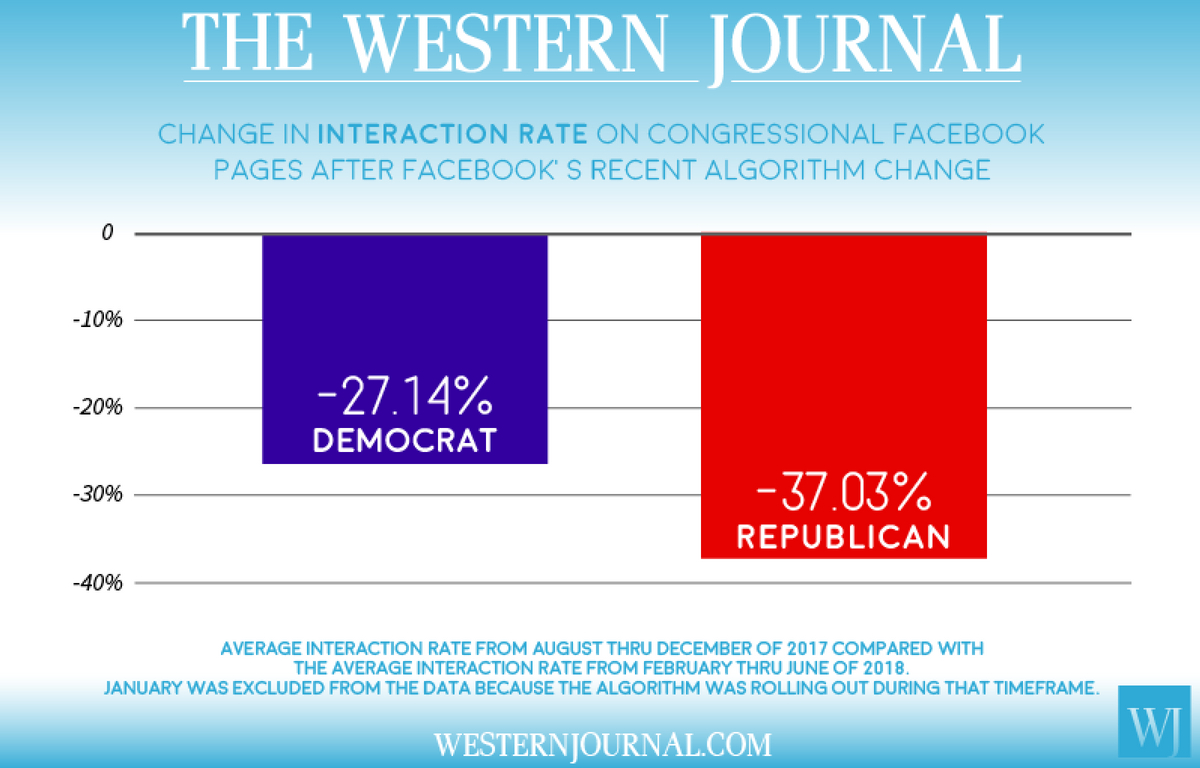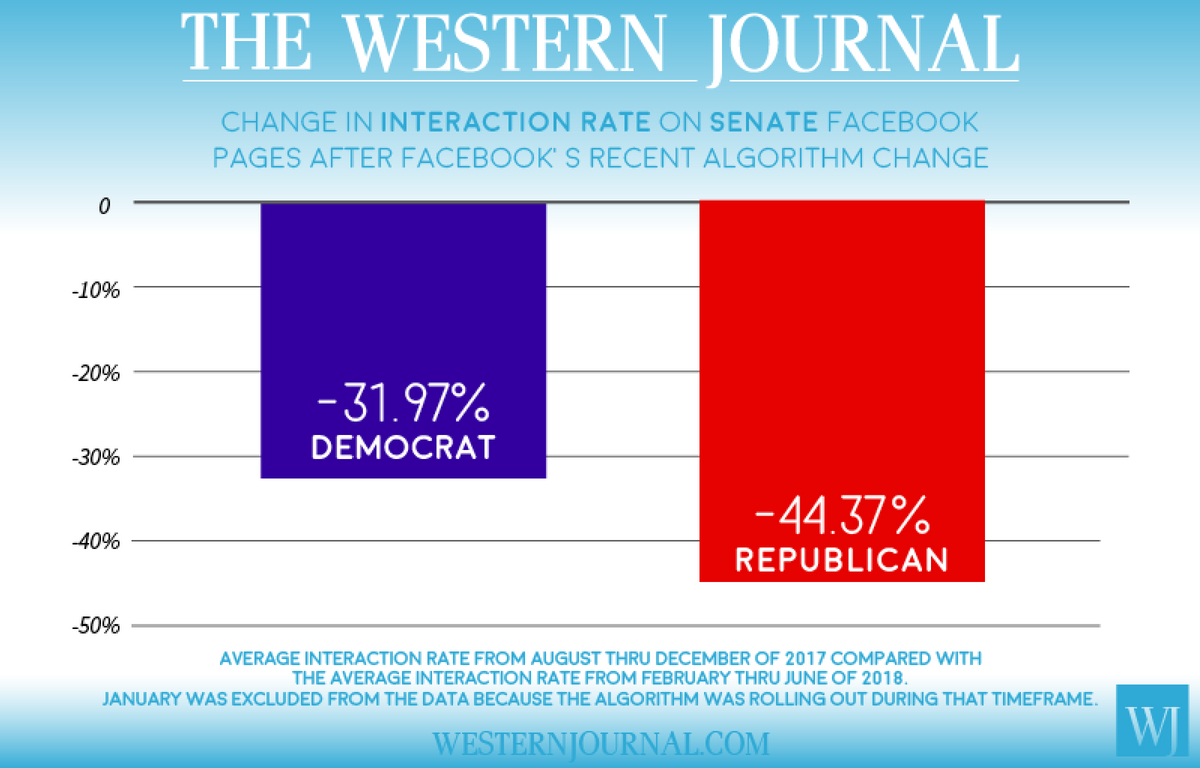Study: US Congress Members Hurt After Facebook Algorithm Change, But Republicans Hit Harder
Following a change Facebook made to its News Feed algorithm in January, the ability of members of Congress to communicate with their constituents through the world’s largest social media platform has dropped dramatically, according to analysis by The Western Journal.
After Facebook’s January algorithm changes, pages associated with members of both major parties saw a significant decrease in interactions with readers, but the Facebook pages of Republican members of the House and Senate were impacted measurably more than those of their Democrat counterparts.
The exclusive report showed that the interaction rate on Republican congressional Facebook pages decreased by 37 percent, compared to a change of just over 27 percent on Democrat-operated pages.

In January, Facebook CEO Mark Zuckerberg announced that the company would be making changes to users’ News Feeds, with the stated purposes of “helping you find relevant content (and) helping you have more meaningful interactions.”
This algorithm change would place more posts from “friends, family and groups” in News Feeds and “less public content like posts from businesses, brands, and media.” Additionally, Facebook also said it would focus on news from “trustworthy” publications that people find “informative.”
Previous analysis by The Western Journal had showed that the demotion of publishers’ content in users’ news feeds had apparently impacted conservative-leaning publishers significantly more than liberal-leaning outlets. A similar trend appears evident when the Facebook pages of elected federal officials are considered.
The Western Journal downloaded months of pre- and post-algorithm change data through CrowdTangle, a social monitoring platform owned by Facebook, for congressional Facebook pages from August 2017 through June 2018. The charts below compare data from the five months prior to January to the five months after January. (January 2018 data was omitted because the algorithm change was made partway through the month.)
The Western Journal looked at total interactions — reactions, comments and shares on a post — and interaction rates — average interactions divided by the number of page followers for each page. Regardless of a change in the number of posts or followers, the interaction rate on a given Facebook page should remain similar from month to month, all else being equal. (The graph below is interactive to allow readers to see the data for themselves.)
According to our analysis, the interaction rate on Republican Facebook congressional pages decreased by 37 percent, compared to a change of just over 27 percent on Democrat pages.
Moreover, total interactions on Republican congressional members’ Facebook pages decreased by 34 percent, while total interactions on Democrat congressional members’ Facebook pages decreased by 18 percent.
While interaction rates fell across the board after Facebook’s algorithm change, Republican senators and House members saw a more significant drop in the interaction rates on their Facebook pages than did their Democrat counterparts.
Among senators, the interaction rate on Republican pages decreased by over 44 percent, while Democrats saw a 32 percent decrease.

In the House of Representatives, the interaction rate on Republicans’ Facebook pages decreased by 32 percent while the interaction rate on pages operated by Democrat representatives’ pages decreased by 25 percent.

Video Interaction
Total video interactions (not including Facebook Live videos) on Republican pages decreased by 49 percent while total video interactions on Democrat Facebook pages decreased by 28 percent.
The interaction rate on Republicans’ videos declined by 46 percent, while the rate on Democrats’ videos decreased by 33 percent.
It should be noted that, since the number of videos posted during the periods in question was relatively small, a wider variation in these numbers is not as surprising as it may at first appear.
Photo Interaction
Photo interactions on Republican members’ pages decreased by 24 percent, with a 35 percent decrease in interaction rate.
Photo interactions on Democrat pages declined by only 6 percent, with a 26 percent decrease in photo interaction rate — very similar to the rate decrease seen by Republican pages.
Link Interaction
Link interaction rate decreased on Republican Facebook pages by 32 percent decrease in interaction rate while the Democrats experienced a 17 percent decrease.

Total link interactions decreased on Democrat Facebook pages by 10 percent but Republicans suffered over three times that amount with a 31 percent decrease in interactions.
Case Study: 2016 Presidential Candidates
Some senators account for a larger percentage of interactions than others, most notably those who ran for president in 2016.
Sen. Bernie Sanders — who caucuses with the Democrats — accounts for 60 percent of the total interactions on Democrat Facebook pages. His official Facebook page has 7.4 million followers as of July 18. Because of this, his two pages (personal and official) are dramatic outliers in the data.
Excluding the data from Sanders’ pages, the difference in interaction rate on Republican and Democrat members of Congress Facebook pages is closer. In this scenario, Republicans experienced a 37 percent change in interaction rate on their Facebook pages while Democrats experienced a 32 percent change in interaction rate.
In the Senate, excluding Sanders’ pages, the interaction rate on Republican Facebook pages decreased by 44 percent and the interaction rate on Democrat Facebook decreased by 40 percent.
When Republican senators who ran for president in 2016 — Sens. Marco Rubio, Ted Cruz and Rand Paul — are also removed from the data, there is a greater variance in interaction rates. Interaction rates on Republican Facebook pages decreased by 41 percent while interaction rates on Democrat Facebook pages decreased by 32 percent.
In the Senate, without the data from Sanders, Rubio, Cruz or Paul, there was a 61 percent change in interaction rate on Republican Facebook pages and a 40 percent change in interaction rate on Democrat pages.
Where does this data come from?
To conduct this evaluation, The Western Journal pulled Facebook data from CrowdTangle, which is owned by Facebook, for all members of this current Congress with a Facebook page. That data was aggregated for Facebook pages from August 2017 through June 2018.
The analysis described herein does not include data from Facebook pages that did not post during any one of the 11 months of data pulled. Out of the 577 congressional Facebook pages available, only 81 were eliminated from the analysis because of this.
The two independent senators, Sens. Bernie Sanders and Angus King, were included with the Democrats because they caucus with the Democratic Party.
The Western Journal then took the data from CrowdTangle and calculated each Congress member’s monthly interaction rate using the total interactions on the page, total posts, and total page likes.
The total interactions are the total number of reactions, shares and comments on a Facebook post.
The interaction rate was calculated by averaging the number of interactions for all of the account’s posts in the specified time frame and then dividing that number by the number of followers of that page (averaged over the time period).
The pre-algorithm change data includes all data from August through December 2017; the post-change data includes all data from February through June 2018.
The data used for this analysis measures users’ interactions with the posts and not the reach of the post. Reach data is available only to individual publishers and is not made public by Facebook. However, the interactions are good general indicators of reach because when more users see a given post, interactions with that post should rise accordingly.
Asked for comment, a Facebook spokesman sent a short statement by email:
“We updated News Feed to help people meaningfully connect with friends and family first. As News Feed prioritizes posts from friends, it means public Pages of all types have experienced declines, regardless of political perspective. In fact, while our own analysis shows decreases across the board for Republican and Democratic member Facebook Pages, there have been large spikes driven by conversation about news events, such as tax cuts last December and the immigration debate in June.”
It is true that if one were to remove December of 2017 and June of 2018 — months that had significantly more interactions than the rest of the months within the data sample — the difference in interactions and interaction rates would be much less. The Western Journal chose to leave those months in the analysis because rises and falls in political engagement are a normal historical occurrence and that reality seems to reflect a more accurate picture of traditional political discourse.
The data analyzed by The Western Journal showed those spikes in interaction rate as well. However, because Facebook reveals a limited amount of data regarding public pages — and essentially no data at all about the algorithm used to show posts on users’ News Feeds — the ability of users, journalists and others to analyze cause and effect is extremely limited.
What is clear is that the ability of your elected officials in Congress to communicate with you through Facebook has been directly and unilaterally reduced by the January algorithm change, and that Facebook’s significant lack of data transparency makes it impossible for The Western Journal, government regulators or anyone else to defend Facebook’s internal processes as unbiased, make a credible accusation of intentional bias, or make any sort of defensible statement in between.
Therefore, The Western Journal has analyzed the data available to us, and invites you to do the same. For the full data set, visit this public Google Sheet. To interact with the data set, visit this webpage.
Maxwell Knowles contributed research to this analysis. Charts by Hannah Nolcheff. Shortly after its original publication, minor changes were made to this article to increase clarity.
Truth and Accuracy
We are committed to truth and accuracy in all of our journalism. Read our editorial standards.
Advertise with The Western Journal and reach millions of highly engaged readers, while supporting our work. Advertise Today.













